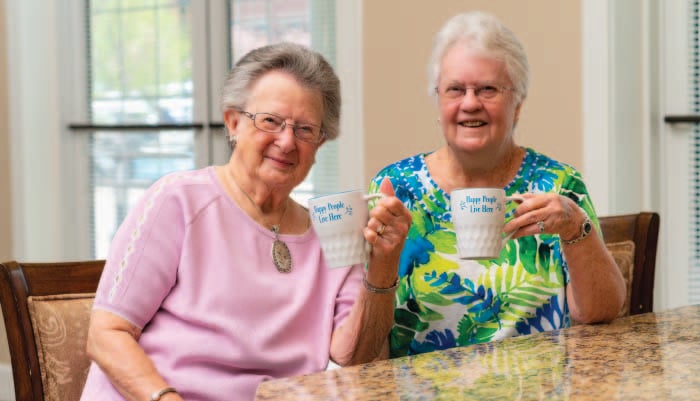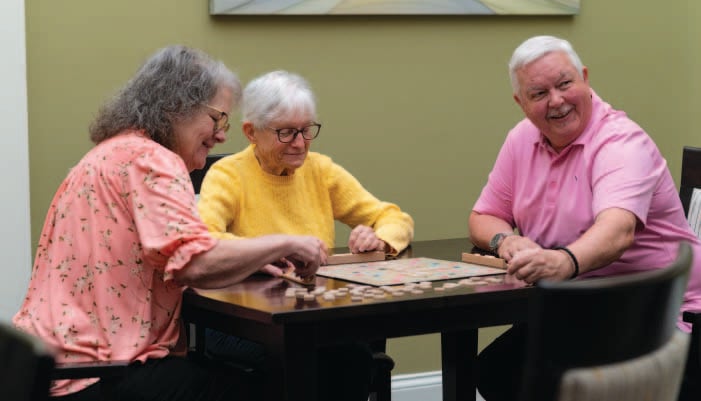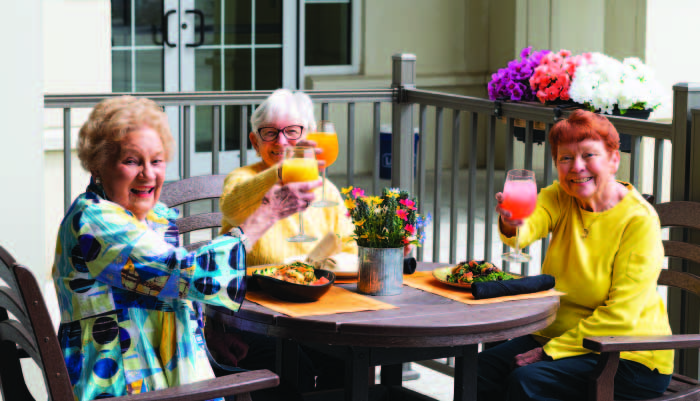When asked where they prefer to spend their final years, most Americans say they'd rather stay in their homes than move anywhere else. While that appears to make sense on the surface, there are many reasons why staying at home to age in place might not be the best option for everyone.
The Impact of Living in a Community
The Mather Institute is conducting a five-year analysis called the Age Well Study that looks at the impact of living in a Life Plan Community, also known as a Continuing Care Retirement Community (CCRC). Early findings indicate that the majority of residents felt their social wellness had somewhat or greatly improved after moving into a community.
And researchers found that, on average, Life Plan Community residents showed low levels of stress and high levels of resilience during the pandemic. Research continues to support the conclusion that moving into a Life Plan Community or a CCRC is likely a better overall long-term plan, even for those individuals who are physically independent.
Experience life at a Continuing Care Retirement Community >>
How does this work?
Let’s use the acronym “ABCs” (Accessibility, Budget, Chores, and Socialization) to compare the reality of staying at home with the opportunity to move to a CCRC.
Accessibility: Aging at Home vs. Moving to a CCRC

Aging at Home
Most private homes are not designed to accommodate the needs of seniors, including common considerations such as wider hallways for walkers or entry ramps and lower sinks for wheelchairs.
Home modification costs can add up quickly. And, in some two-story homes, it often isn’t possible for floor-plan changes that will allow for safer mobility between levels.
Moving to a CCRC
Continuing Care Retirement Communities are intentionally built to address the needs of older adults. Most include single-floor homes with larger windows to allow abundant natural light, walk-in showers and comfort-height toilets, levers instead of doorknobs, and a built-in call button or security system to ensure safety.
Residents are often surprised — and delighted — by some of these small adjustments that make life easier and more enjoyable.
Budget: Aging at Home vs. Moving to a CCRC

Aging at Home
While it may seem that a home without a mortgage would be the least expensive alternative, that is often not the case. Those unexpected major repairs, from replacing a furnace or major appliance to fixing a leaky roof, can add up quickly. Don’t forget that there are also utility bills, annual property taxes, insurance premiums, and more.
Furthermore, what happens when you need help? According to the article, Living at Home Isn’t Living for Free, more than two-thirds of all adults over the age of 65 will eventually need some type of care.
When you choose to age in place in your home, in-home caregivers average at least $19 per hour. Many seniors that choose to age in place at home eventually wind up paying for assistance with housekeeping, maintenance, meal preparation, or personal care — and these costs can accumulate fast.
How much does independent living at Otterbein cost? >>
Moving to a CCRC
Continuing Care Retirement Communities can provide budget stability. For a fixed monthly fee (and predictable annual increases), you will receive a maintenance-free home or apartment that typically includes utilities, campus-wide Wi-Fi, internet and television services, regular housekeeping, and groundskeeping services.
Extra services such as a meal plan with chef-prepared menus, access to the fitness center, hobby spaces, libraries, or hair salons are also often included.
Additionally, certain contract types provide significant tax advantages by permitting you to deduct the cost of pre-paid long-term health care. Your first impression may be that you cannot afford a monthly fee, but if you do a side-by-side comparison, you may find a community will actually save you money!
Chores: Aging at Home vs. Moving to a CCRC

Aging at Home
There comes a time when tasks such as mowing the lawn, raking leaves, shoveling snow, grocery shopping, cooking, cleaning, and doing laundry become less enjoyable and often more difficult. This could result in the need to hire someone to provide these services, which is an added expense in the budget.
There may also be an increased risk for falls and injuries that comes with tasks like using a ladder or stepstool.
Why the best age to move to a CCRC is younger than you think >>
Moving to a CCRC
Continuing care communities like Otterbein SeniorLife give you the most valuable non-renewable resource: time! You'll receive freedom from home maintenance and other daily chores and the opportunity to enjoy a high quality of life.
Most residents look forward to additional time to pursue old or new hobbies and celebrate life with friends and family. Now is the time to make each day count, by substituting what you “have to do” with doing what you love!
Socialization: Aging at Home vs. Moving to a CCRC

Aging at Home
Your home address may be comforting and familiar, but do you consider your neighbors to be like a family? Do you feel part of a community with a strong support network? Sometimes, as life gets hectic, visits from friends and family may become less frequent, and inclement weather could keep you at home more than you'd like.
This can lead to isolation, which is a common concern for older adults who remain in their homes. The National Institute for Mental Health has declared depression a major public health issue, impacting nearly half of females over age 75 who live alone.
Moving to a CCRC
Socialization and a sense of belonging are important predictors of happiness for older adults. Most residents experience an improved overall sense of wellbeing after moving to a continuing care community.
The majority of communities offer common areas to interact with others of a similar age and meet new friends through fitness classes, book groups, card clubs, hobby and activity spaces, lectures, or outings. Normally, there's something for everyone living in a CCRC — you can choose to do as much or as little as you'd like every day.
A Closer Look at the Cost of Senior Living
Aging in place can happen no matter where you live. However, by living in a CCRC, you and your family often gain peace of mind knowing that you have a plan in place to meet your needs as they change.
Click the button below to get your free planning guide, which includes an Otterbein SeniorLife cost comparison worksheet. You'll learn how to evaluate your financial situation, get tips on finding the right community, and explore the most common financing options.


